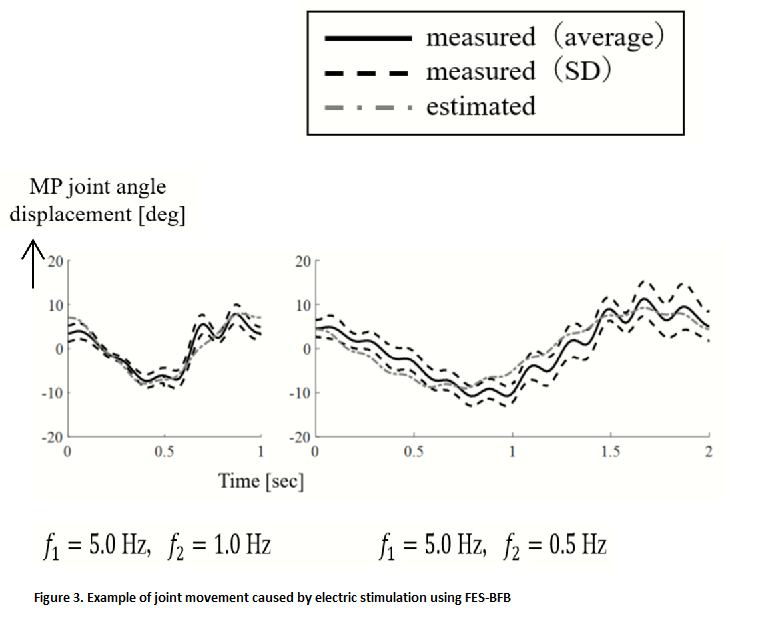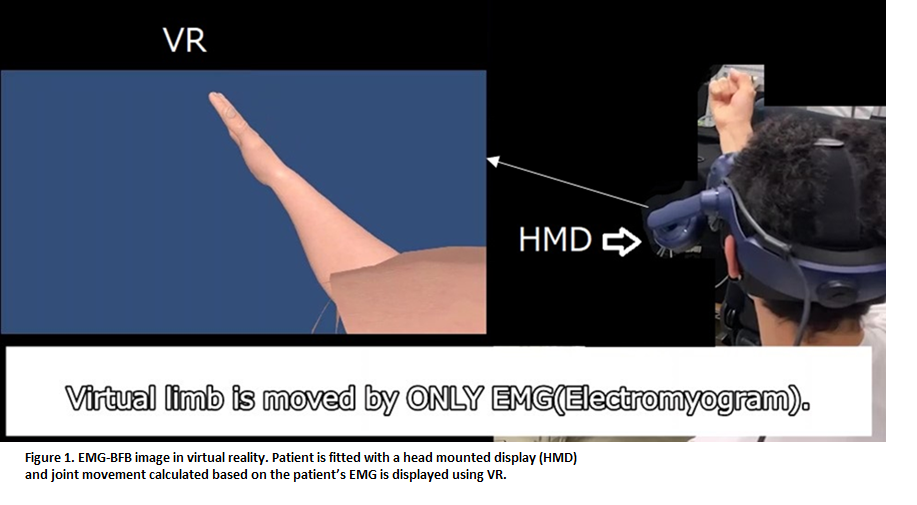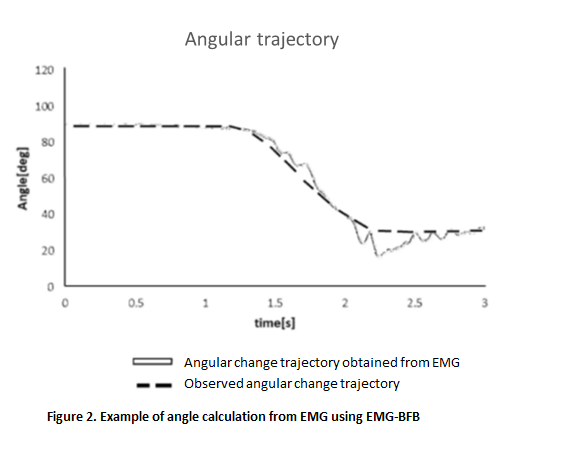Functional electrical stimulation and virtual/augmented reality electromyographic biofeedback system and new testing methods for physical characteristics that can be performed using this system
April 28, 2022
- Background / Context / Abstract:
Electromyographic biofeedback (EMG-BFB), currently used in clinical practice, converts single muscle EMG into diagrams, graphs, or sounds that are passed on to patients. The acquired EMG cannot provide feedback converted into “meaningful information” that the patient can understand, in other words, movement predicted by the EMG. As a result, it is necessary to achieve EMG-BFB in which patients can learn how to change the EMG feedback to realize the desired movement.
In addition, an FES-BFB system has been proposed that, in combination with functional electrostimulation biofeedback (FES-BFB), acquires weak EMG of the paretic limb and performs electrical stimulation according to its intensity. This augments voluntary movement of the paretic limb and stimulates motor relearning of the brain, but it does not predict the movement achieved from EMG and properly stimulate it, and may amplify compensatory movements that should be suppressed.
In order to resolve the above problems, we propose a model based EMG-BFB or FES-BFB using a model that reflects human body characteristics. By using this model, it is possible to calculate the movement created from EMG, and to calculate the electrical stimulation pattern for achieving the desired movement.
Next, we propose an inspection method for acquiring human body characteristics. This is accomplished by electrical motor modeling [1 -3]. The system identification is carried out by expressing the stimulation intensity to multiple muscles with the reciprocal action by two variables (Electrical Agonist-Antagonist Muscle Ratio: EAA Ratio and the Electrical Agonist-Antagonist Muscle Sum: EAA Sum), and by entering these into a human neuromusculoskeletal system model to acquire model parameters (stiffness, viscosity, waste time) as a body characteristics.
[1]Kazuhiro Matsui et al., “Analysis of a 2 ch type functional electrical stimulation (FES) equilibrium-point control model for extension to an unconstrained environment in horizontal elbow-joint movement.” Biomedical Engineering, 2015, Vol. 53, No. 1, pp. 14-20.
[2]Kazuhiro Matsui et al., “Equilibrium-point control of human elbow-joint movement by using multichannel functional electrical stimulation: Verification in an isometric environment.” Journal of the Society of Instrument and Control Engineers, 2014, Vol. 50, No. 11, pp. 755-762.
[3]Kazuhiro Matsui et al. , ”Equilibrium-point control of human elbow-joint movement under isometric environment by using multichannel functional electrical stimulation.” In Mitsuhiro Hayashibe, David Guiraud, Jose L. Pons, Dario Farin, eds., “Biosignal Processing and Computational Methods to Enhance Sensory Motor Neuroprosthetics.” Frontiers in Neuroscience, 2015, pp35-43.
Technology Overview:
This technology consists of the BFB aspect and test aspect. These can also be used independently. The BFB aspect includes EMG-BFB and FES-BFB.
・EMG-BFB
This system provides visual feedback using virtual/augmented reality (VR/AR) using a head-mounted display. It can also be used with regular monitors. From EMG acquired from an electrode attached to the skin, change in joint angle is calculated using a model which reflects body characteristics, providing visual feedback by reflecting and projecting this on a displayed virtual body. Tactile feedback can also be used to increase the effect.
・FES-BFB
The electric stimulation pattern necessary for achieving the desired movement shown on the monitor and VR/AR is calculated using the model which reflects the body characteristics, and it is applied to the human body through an electrode attached to the skin. Because the human muscle contracts as a result of the external electric stimulation instead of the EMG, the movement desired through this action is achieved and experienced by the body.
・Test aspect
By identifying response characteristics of the body when electric stimulation is applied, physical characteristics can be acquired as model parameters. How these model parameters change by EAA sum can be formulated for each individual.
Benefits:
Using EMG-BFB with VR/AR, it is possible to experience the characteristics that differ to your own body in a virtual environment. By setting the characteristics of the virtual body, for example, when it is healthy, the paralyzed patient can experience a healthy body during rehabilitation. This is an effective method to promote the relearning of internal models in the brain.
There are also applications in the sporting field, such as experiencing the physical characteristics of an athlete, and other applications where you can place an avatar with your physical characteristics in a virtual environment and project yourself into a virtual environment.
FES-BFB is expected to promote brain recovery in rehabilitation because it provides the experience of actually moving one’s paralyzed body.
In addition, the new physical characteristics obtained from test aspect can be used as a new index to express nerve transmission and contraction characteristics of the muscle as parameters, such as rigidity, viscosity, waste time, etc.
Potential Applications / Potential Markets:
・New VR/AR-based therapeutic device for the rehabilitation market for neurological disorders, such as stroke, or orthopedic diseases
・Training equipment utilizing VR/AR in the sports training market
・A new physical characteristic testing device that can be used for rehabilitation in the preventive medicine market
・Avatars that can be used to reflect physical characteristics in the metaverse market
State of Development / Opportunity / Seeking:
・Available for exclusive and non-exclusive licensing
・Exclusive/non-exclusive evaluation for defined period (set up for options)
・Collaborative/supportive research
※Seeking
1. Development partner
2. Licensing
IP Status:
PCT applied in Japanese
Figures:

Contact:
![]()

